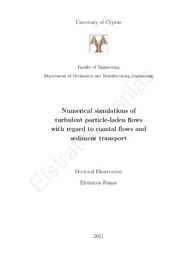Numerical simulations of turbulent particle-laden flows with regard to coastal flows and sediment transport

View/
Date
2021-12Publisher
Πανεπιστήμιο Κύπρου, Πολυτεχνική Σχολή / University of Cyprus, Faculty of EngineeringPlace of publication
CyprusGoogle Scholar check
Keyword(s):
Metadata
Show full item recordAbstract
Στην παρούσα διατριβή, το γενικό φαινόμενο της μεταφοράς ιζήματος θα μελετηθεί ενδελεχώς. Ειδικό ενδιαφέρον θα δοθεί στις αριθμητικές προσομοιώσεις τυρβωδών ροών με σωματίδια ως κομμάτι των εφαρμογών μεταφοράς ιζήματος. Η ροή του ρευστού προσομοιώνεται μέσω της Προσομοίωσης των Μεγάλων Δινών ή Large Eddy Simulation (LES) όπου οι πιο ενεργές κλίμακες της ροής επιλύονται και οι μικρότερες κλίμακες μοντελοποιούνται με χρήση μοντέλων τύρβης από τη βιβλιογραφία. Τα στερεά όρια και τα παρεμβαλλόμενα στερεά εντός της ροής λαμβάνονται υπόψη μέσω της μεθόδου του Εμβαπτισμένου Ορίου ή Immersed Boundary Method (IMB). Τα ιζήματα προσομοιώνονται μέσω ενός Lagrangian μοντέλου που θεωρεί ότι η στερεή φάση του ιζήματος αποτελείται από έναν πεπερασμένο αριθμό σωματιδίων. Τα σωματίδια αυτά μπορούν να αλληλεπιδρούν με το περιρρέον ρευστό καθώς και μεταξύ τους, μηχανισμοί γνωστοί ως 4-way coupling. Πρώτον, θα μελετηθεί η μεταβατική/τυρβώδης παλλόμενη ροή γύρω από αγωγούς πλησίον πυθμένα. Είναι υψίστης σημασίας να αποδειχθεί ότι το θεωρούμενο μοντέλο μπορεί να αναπαράγει τα χαρακτηριστικά της ροής όπως αναμένονται και με ακρίβεια. Έπειτα το επιβεβαιωμένο μοντέλο θα χρησιμοποιηθεί για την ποσοτικοποίηση της έγχυσης στροβίλων (vortex shedding) και της υδροδυναμικής φόρτισης στους αγωγούς σε ένα εύρος διατομής και απόστασης από τον πυθμένα. Δεύτερον, το Lagrangian μοντέλο θα χρησιμοποιηθεί για έναν μικρό αριθμό σωματιδίων που κινούνται εντός παλλόμενου οριακού στρώματος. Κάθε όρος της εξίσωσης κίνησης των σωματιδίων θα εκτιμηθεί σε όρους μέγιστου εύρους ούτως ώστε να προσδιοριστεί ποιες από τις δυνάμεις είναι σημαντικές σε τέτοιες υδροδυναμικές συνθήκες. Στη συνέχεια θα διενεργηθεί μία αριθμητική προσομοίωση ομοιόμορφης τυρβώδους ροής με σωματίδια πάνω από πυθμένα γεωμετρίας θινών. Η σωματιδιακή φάση που συντίθεται από πάνω από ένα εκατομμύριο σωματίδια και οι πλήρεις δυνατότητες του Lagrangian μοντέλου (4-way coupling) θα ληφθούν υπόψη. Η κίνηση των σωματιδίων, η επίδρασή τους στις ταχύτητες της ροής και οι διατμητικές τάσεις πυθμένα θα ποσοτικοποιηθούν. Τα αποτελέσματα θα συσχετισθούν εκ των υστέρων με μία φόρμουλα υπολογισμού ιζήματος κλίνης από τη βιβλιογραφία, ώστε να εκτιμηθεί η δυνατότητα ο πυθμένας να υποστεί διάβρωση/απόθεση. Τέλος, συνοψίζοντας τα συμπεράσματα της παρούσας ερευνητικής εργασίας, θα γίνουν συστάσεις για μελλοντικούς ερευνητές ώστε να χρησιμοποιήσουν τα αποτελέσματα της εργασίας μας και να προχωρήσουν μπροστά ερευνητικά. In the present thesis, the general phenomenon of sediment transport will be thoroughly investigated. Specific interest will be given to numerical simulations of particle-laden turbulent flows as part of sediment transport applications. The flow motion is simulated by means of Large Eddy Simulation (LES) where the most energetic flow scales are resolved and the subgrid scales are modeled using turbulence models from the literature. Solid boundaries and bluff bodies within the flow are taken into account by means of the Immersed Boundary Method (IMB). Sediments are simulated by means of a Lagrangian model which considers that the sediment phase consists of a finite number of particles. Those particles can interact with the carrier fluid and also with each other and solid boundaries through collisions, mechanisms known as 4-way coupling. Firstly the transitional/turbulent oscillatory flow around near-bed pipelines will be investigated. It is of high importance to prove that the considered model can accurately capture the flow characteristics that are anticipated. Then the validated model will be used to quantify the vortex shedding and the hydrodynamic forcing on the pipelines in different range of pipeline diameters and distance from solid bed. Secondly, the Lagrangian model for a small number of particles moving within oscillatory boundary layer flow will be used. Each term of the equation for particle motion will be evaluated in terms of magnitude in order to determine which forces are important in such hydrodynamic conditions. Then, a numerical simulation of turbulent particle laden unidirectional flow over a dune-shaped bed will be conducted. The particle phase consisting of over a million particles will be released and the full capabilities of the Lagrangian model (4-way coupling) will be taken into account. The particle motion, their effect on the fluid velocities and the bed shear stresses will be quantified. The results will be offline coupled with a literature formula for bedload transport to determine potential bed erosion/deposition patterns. Finally, after summarising the conclusions of the present research work, certain recommendations will be made for future researchers in order to use our research results and take steps forward.
